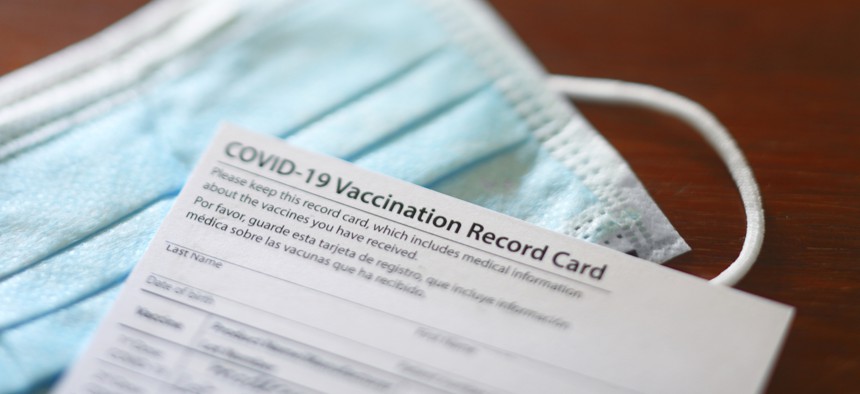
DNY59/iStock
Is This the End?
The CDC’s surprising mask announcement was not just a public-health milestone.
The announcement seemed to catch everyone off guard: Early Thursday afternoon, the government told Americans that if they were fully vaccinated against COVID-19, they did not need to wear a mask—indoors or outside, in groups small or large.
People who have gotten their shots, Rochelle Walensky, the CDC director, said at a White House press briefing, “can start doing the things that you had stopped doing because of the pandemic.” Coming from an administration that has preached caution to the point of criticism—only six weeks ago a teary-eyed Walensky warned the nation of “impending doom”—the words sounded like a surprisingly abrupt declaration of freedom: Did the CDC just end the pandemic?
It had not, of course. There were, as always, plenty of caveats to the CDC’s guidance. Masks should still be worn on public transportation and in high-risk settings such as doctor’s offices, hospitals, and nursing homes. The majority of Americans remain unvaccinated and should continue to mask up. Tens of thousands are testing positive for the coronavirus every day, and hundreds are still dying from it. Cases are surging in India and other parts of the world.
So, no, the pandemic isn’t over, but the significance of the CDC’s shift was unmistakable, and the nation’s senior political leaders made sure the public didn’t miss it. Inside the Oval Office, President Joe Biden and the Republican lawmakers with whom he was meeting took off their masks, Senator Shelley Moore Capito of West Virginia told reporters outside the White House. On the Senate floor, Senator Susan Collins of Maine—who earlier this week chastised Walensky over the CDC’s “conflicting” mask guidance—triumphantly waved hers in the air. “Free at last,” Senate Minority Leader Mitch McConnell, previously a fastidious mask-wearer, declared at the Capitol. Conservatives have mocked Biden, who has been fully vaccinated for months, for wearing a mask even when it clearly offered no discernible health benefit, including while walking alone to and from his helicopter. So when Biden spoke later in the afternoon in the White House Rose Garden, it was notable that he wasn’t wearing one. His remarks carried an air of celebration, if not quite finality. “Today,” he said, “is a great day for America in our long battle with the coronavirus.”
[Read: The liberals who can’t quit lockdown]
The impact of today’s announcement—like that of so many others during the past 15 months—will vary greatly across the country. For the millions of people who have long refused to wear masks, it will make little difference. Plenty of others will ignore it; in New York and other cities, people regularly wear masks as they walk down the street even though the CDC relaxed guidelines for outdoor activities weeks ago. Businesses and local governments could continue to require them. For many, the announcement immediately raised anxiety and a host of new questions, particularly among parents of children who are too young to be vaccinated. Is it safe to bring kids into a grocery store where people aren’t wearing masks? What about the immunocompromised for whom the vaccines might be less effective? How do you know whether a maskless person is vaccinated? Enforcement is impossible. (“It’s not an enforcement thing,” Biden said. “We’re not going to go out and arrest people.”)
The president and the CDC framed the change as one more incentive for people to become vaccinated by presenting the vaccine-hesitant with a choice—get your shot if you don’t like wearing a mask. But the guideline change was also at least a tacit acknowledgment that not everyone is going to become vaccinated and that at some point the country needs to move closer to normalcy anyway. With cases dropping across the country, the CDC was under increasing pressure to loosen its position toward masks.
Biden has promised, over and over again, to remove politics from the decision making around the pandemic, to “follow the science.” But the political implications of today’s announcement were inescapable. The president needs the pandemic to end, but he also needs the public to see that his policies and leadership have helped make it end. So far, his success has been measured mostly in numbers—in the falling infection rate and in the hundreds of millions of vaccinations, which have exceeded the administration’s initial stated goals. Liberating the people from their face coverings is a far more visible step—one that Americans will feel, physically as well as symbolically, in their daily lives. It will also ease one of the most polarizing issues of the pandemic. The harsh political reality is that people might be more willing to credit Biden for ending the mask mandates than they are for keeping them healthy.
Undoubtedly, a few more twists and turns in the pandemic lie ahead, and the administration’s shift might yet prove to be premature. The ongoing global spread of the virus could spawn new variants that evade the vaccines, and the duration of the protection offered by the shots is still unknown. Masks will be a part of American life in certain settings for months to come, if not longer. For more than a year, however, these flimsy garments have come to symbolize the intrusion, and the isolation, wrought by COVID-19. When the pandemic is finally indeed over, the country might look back at the unexpected announcement of May 13 as a moment of demarcation—even as something of an end.
This article was originally published in The Atlantic. Sign up for their newsletter.






